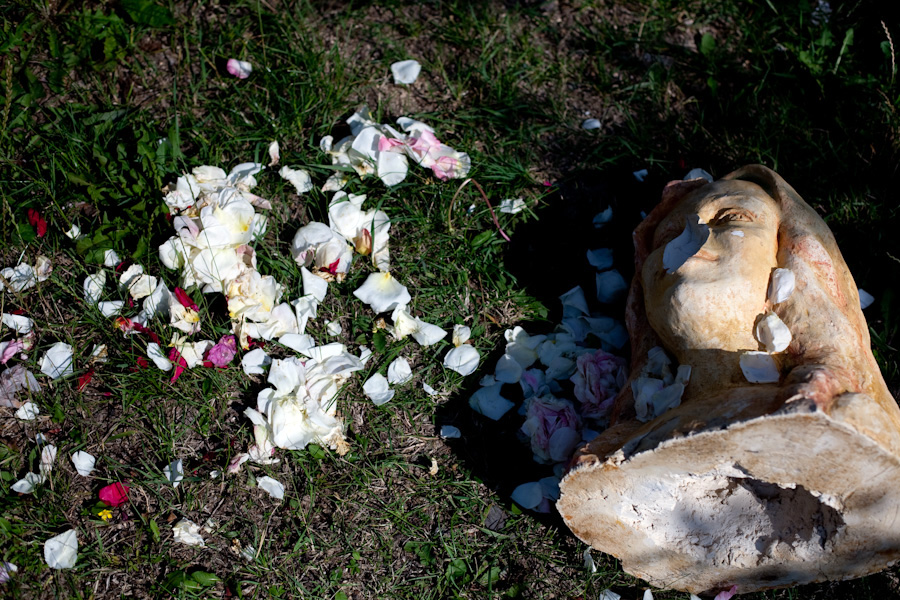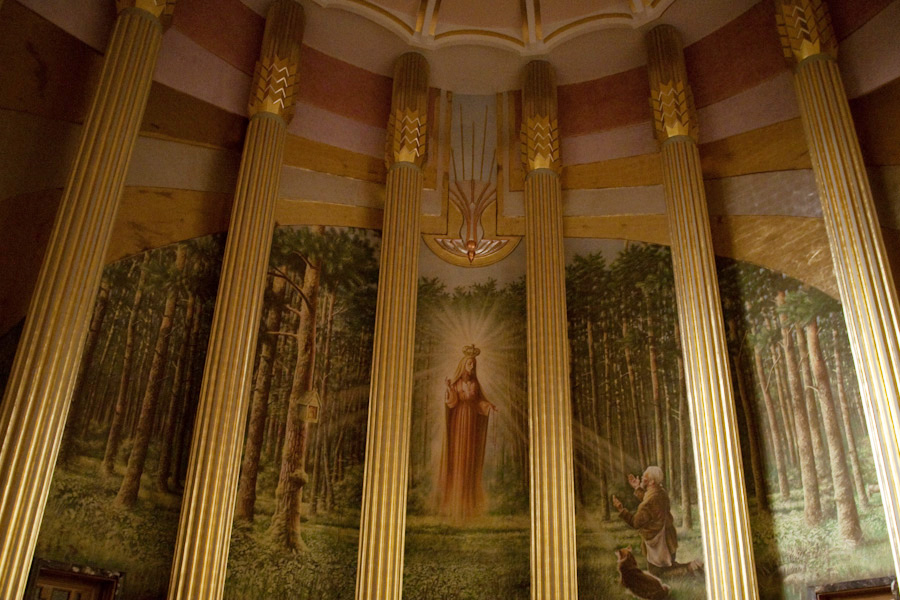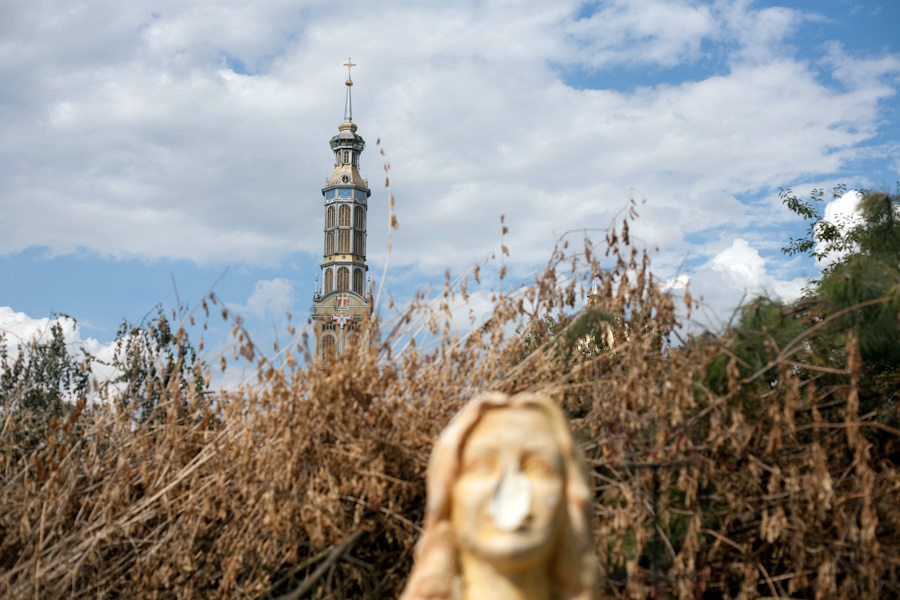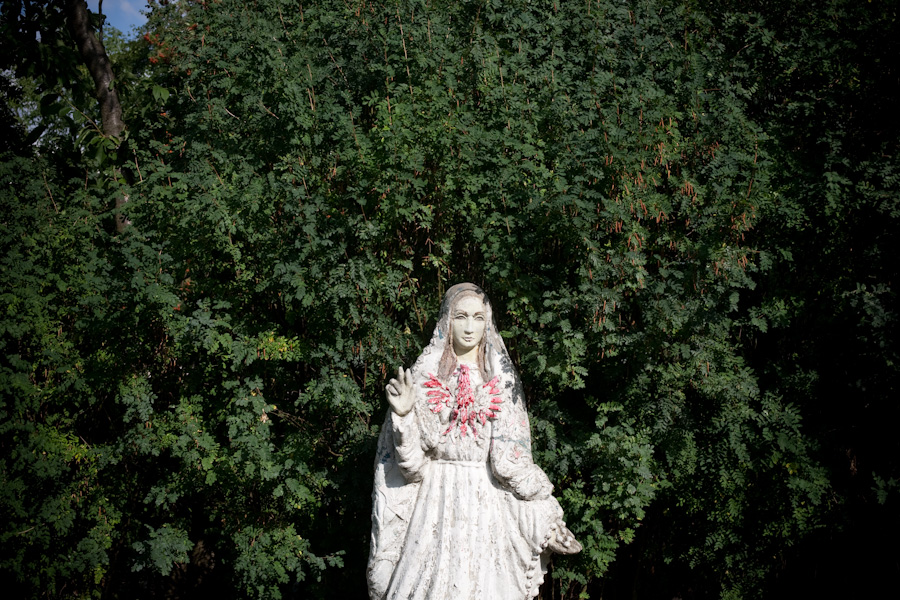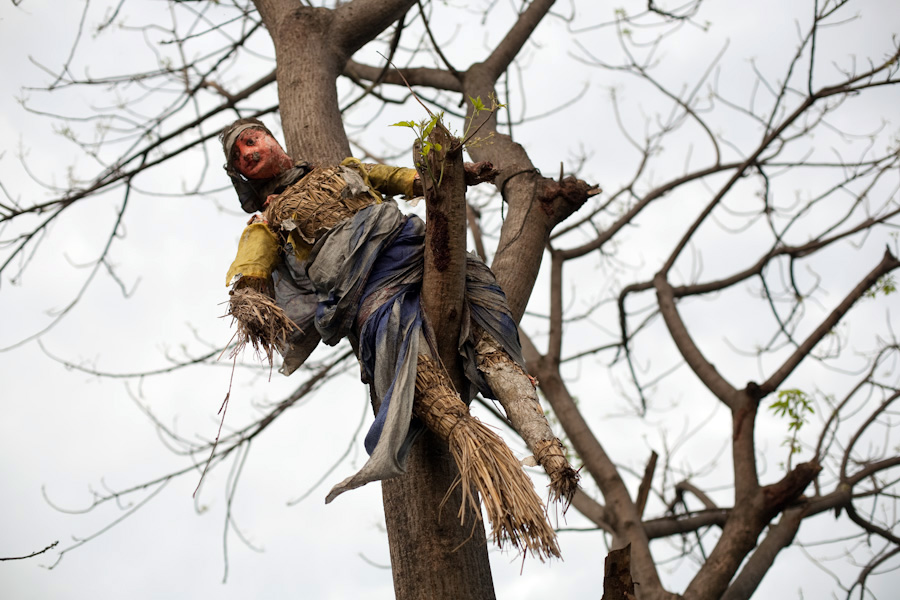Na północnej półkuli rozpoczął się właśnie szczególny miesiąc, poświęcony Bogini. To czas, kiedy na rozpoczęcie wiosny w bagnach i rzekach topiono Marzanne (“marzec”) , ducha zboża, ostatni snop z poprzednich zbiorów, Panią Plonów i Dawczynie Życia, przechowywaną w chałupie przez okres mrocznej zimy, to czas kiedy Bogini o dwóch obliczach objawia swą życiodajną stronę, a Straszna Starucha, Durga, Baba Jaga z matecznika lasu, celtycka cailleach, umiera, w niekończącym sie cyklu pór roku, gdzie życie i śmierć są tym samym. Mizogini i głosiciele naiwnego dualizmu usiłujący od setek lat na tych ziemiach demonizowac Te Które Wiedzą jako kochanki Złego, zdołali swoimi świętami zaledwie dopasować się do prastarych rytuałów, nie mogąc zaprzeczyć naturze, ubrali je w swe dekoracje i nakazali wielbić Maskę, jednocześnie zaprzeczając temu co ona reprezentuje. Polski katolicyzm jest w swej istocie przede wszystkim kultem Bogini. Zaczynam to rozumieć coraz lepiej, przydał się tu dystans kulturowy, przydały podróże i eksploracje religijnych tradycji świata. Chociaż wydać może się to absurdalne, aby lepiej zrozumieć istotę swych korzeni, wyjeżdżam w tym tygodniu w głąb Amazonii, gdzie współczesne synkretyczne kulty czczą Panią z Lasu, również ubraną w kostium Matki Boga, Bogurodzicy. To Pradawna Matka a jej syn różne nosił imiona, tak jak różny jest las w którym mieszka, różne plony które się zbiera na polach w różnym klimacie. Pani z dżungli czy prasłowiańskiej puszczy, Pani Kukurydzy , Żyta czy Konopii, pani o wielu twarzach, czasem jasnych, czasem śniadych.
***
In the northern hemisphere a special month has just begun, a month dedicated to the Goddess. This the time for spring to begin, when since pagan time in Slavic times a straw figure representing Goddess named Marzanna ( from the Indoeuropean root -mar or -mor , connected with death, sea and the month of March ) was drowned in marches, rivers or scattered in the fields, as the spirit of grain, inhabiting the last bundle of cereals harvested previous year, the Lady of Harvest and Giver of Life, kept in the house during dark winter. This time is a moment when Goddess with two aspects reveals its life-giving side, and the Terrible Hag, Durga, Baba Yaga from the heart of wild forest, the Celtic cailleach , is dying, in the neverending cycle of seasons of the year, in the universe where death and life are one and the same. Misogynists, preachers of naive dualism trying for hundreds of years in these lands to demonize Those Who Know as lovers of Evil, they have merely managed with their festival times ( like Easter ) to match timing of ancient rituals, as they could not deny natural cycle, they decorated it with their cultural artifacts and imports, and ordered to worship the new Mask, at the same denying and persecuting what it stands for. Polish Catholicism is indeed essentially the cult of Goddess. I see this more and more clearly, what was useful in understanding was cultural distancing achieved by travels, exploration of religious traditions of the world and use of sacred plants. Even though it may seem absurd, to understand my own roots better, I leave this week into the heart of Amazon jungle, where modern syncretic cults worship Lady of the Forest, also dressed in the costume of Mother of God, Holy Virgin ( in the old pagan sense, not as sexually restrained, but as under no rule of man, separate female force ). This the Primordial Mother, Matrix, she and her divine son had many different names in the history, as different are the forests in which she dwells, different the harvest she gives in various lands. The Mother of the Jungle, or of virgin forest of Slavic lands, the Lady of The Corn, or Rye and Cannabis Mother, of many faces, sometimes bright as sun, and sometimes dark.
Tak jak przemocą chrystianizowani Słowianie zastąpili swych wrzucanych w bagna bogów kultem nowej formy bogini, czas wiosennego przesilenia Wielkanocą a pogańskie dożynki ku czci odchodzącego w kolejnym sezonie ducha Żytniej Baby sierpniowym Wniebowstąpieniem Marii Panny, tak też brutalnie eksterminowani Indianie z tropikalnego lasu czy wykorzystywani jak bydło przez chrześcijańskich panów czarni niewolnicy brazylijskich plantacji zachowali ciągłość dawnych wierzeń, i teraz, w epoce kompromitacji patriarchalnego kościoła kulty Boginii mają coraz więcej siły i śmiałości, coraz bardziej otwarcie, coraz dalej od watykańskiej centrali. Oficjalna religia Haiti, vodou, używa dla swych potrzeb częstochowskiej ikony jako ilustracji Erzulie Dantor. Kulty santeria, umbanda, orishas, biorą z katolicyzmu co im wygodne, z murzyńskim wdziękiem i swobodą żonglują narzuconą maską, w poszukiwaniu komunii z Boginią. Wreszcie, w sercu Amazonii, z synkretyzmu pierwotnych szamańskich wierzeń Indian i kulturowego lumpeksu czarnych poszukiwaczy kauczuku narodziło się Santo Daime, Święte Daj-mi, oficjalnie uznana w Brazylii religia, której centralnym sakramentem przywołującym żeńską siłę jest ayahuasca, jedna z najsilniejszych psychodelicznych substancji, molekuła duszy, święty wywar z liany i liści, gotowany w kotle niczym pogański eliksir z przedchrześcijańskiej Europy, w Kotle Śmierci i Odrodzenia, w kotle czarownicy, Wiedźmy, tej która wie, Baby Jagi z matecznika lasu. Las w mojej ojczyźnie wycięto już dawno, w imię dualistycznej ideologii, która głosi Królestwo Niebieskie a nienawidzi Tego Świata, i w konsekwencji, wbrew swym deklaracjom karmiąc szaleńczy materializm zamieniła las w surowiec na papier do spisywania dogmatów, posągi, ławki w martwych kościołach i mieszczące je miasta. Aby zatem odwiedzić Matkę tam, gdzie ona wciąż silna, wyruszam za morze, zataczam kolejne koło, pełen jednak przekonania, że przybliża to Źródła.
Jak wskazują badacze, teonim, od którego utworzone zostało imię Marzanny, ma genetyczny związek z ie. *mar-„mający związek z wodą“, poświadczonym w het. marmar(r)a-, mammarra-, mamara „błoto, toń“, lit. márės, goc. marei, łot. märe, łac. mare „morze“, oset. mal„głęboka, stojąca woda“, arm. mavr„błoto“, sisl. muir, ros. morie„morze“. W kulturze ludowej zwrot „za morzem” znaczy tyle co – w innym świecie, w zaświatach, za śmiertelnymi wodami i przywołuje obraz kosmicznych wód. Włada nimi Matka Boska, która spoczywa „na morzu, na kamieniu”*
***
As christianized by force Slavs replaced their old gods, thrown in the swamps by Christian occupants, with the cult of new form of the Goddess, as spring equinox was replaced with Easter and pagan harvest festivals honouring the spirit of grain, the Rye Mother leaving fields for another winter, with the feast of Ascension of Virgin Mary happening exactly at the same time, so did the brutally exterminated Indians of South American tropical forest or black slaves uprooted from their African homeland and exploited in the plantations of Brasil. The continuity of old beliefs was preserved and now, in the period of discrediting of hypocritical church institutions, those survival forms are gaining more and more strength and courage, more and more open, further and further from the control of old men of Vatican. Official religion of Haiti, vodou, is using now for its purposes the icon of Black Madonna from Polish Czestochowa, as depiction of Erzulie Dantor. Santeria, umbanda, orishas, they take from Catholicism what they need, with negro charm and ease they juggle imported cultural masks, in the search of tools of communion with Goddess. Finally, in the heart of Amazon forest, from the syncretism of primordial shamanic beliefs of Indians and cultural second hand store of black rubbber seekers came Santo Daime, The Sacred Give-me, officially recognized by the government of Brasil religion which considers as its holy sacrament for invoking female spirit the ayahuasca, one of the strongests psychodelic substances, spirit molecule, sacred brew from jungle liana, and leaves, ritually cooked in a cauldron not unlike pagan elixir of pre-Christian Europe, in the Cauldron of Death and Rebirth, in the cauldron of the Hag, The One who Knows, Baba Yaga from the matrix of the forest. Forest of my homeland was wounded and destroyed long ago, in the name of dualistic ideology which preaches Kingdom of Heaven and despises This World, and as consequence, despite its declarations, feeding mad materialism, turned the forest into raw material for paper to write its dogmas on, sculptures to worship and benches for dead churches whose towers replaced forest canopy in the ever growing cities. Therefore, to visit Mother where is still strong, I go beyond the big sea, I make another large circle, convinced however, it makes me nearer to the Source.
As the researchers point out, the root of name of goddess Marzanna is related with Indoeuropean *mar- , “connected with water”, examples can be found in Hetitic marmar(r)a-, mammarra-, mamara ( marsh, depths ), Lithuanian márės, Goth marei, Latvian märe, Latin mare ( sea ), Oset. mal ( deep, standing water ), Armenian mavr “mud”, Russian morie ( sea ). In the folk culture a term “beyond the sea”) means – in the netherworld, beyond waters of death, and invokes image of Cosmic Waters. They are ruled by Mother of God, who lives “in the sea, on a stone”.
“(…) Łączy to jeszcze mocniej Marzannę z dniem 25 marca – Matką Boską Roztworną. Opisany już obrzęd wielkanocny wiązał się więc u źródeł z wiosenną równonocą i dokonującym się podczas niej procesem odrodzenia (odmłodzenia) świata, podczas której Marzanna, bogini uśpionej natury, zimy i śmierci, przemieniała się w Dziewannę, uosobienie rozkwitającego zielenią życia i lata. Następuje wówczas uwolnienie ducha roślinności, szczególnie zboża, na co wskazuje fakt, że w niektórych rejonach Polski w dzień Matki Boskiej Roztwornej rozwiązywano w stodołach snopy, gdyż panowało przekonanie, że gdyby tego nie zrobiono, nie urodzi się zboże. Rozrywanie na polu kukły Marzanny, co miało miejsce w pewnych wariantach obrzędu, miało podobne znaczenie. Po pierwsze łączyło się z przemianą staruchy – wiedźmy (Marzanny) w dziewiczą pannę (Dziewannę), podobnie jak czarna ziemia odradza się po zimie okrywając młodą zielenią, po drugie – zniszczenie związanego snopka słomy lub słomianej kukły jest jednoznaczne z uwolnieniem mieszkającego w nim ducha – Matki Zboża, teraz, od zasiewu do żniw strzegącego na polu przyszłych plonów (…)*
***
“(…) It connects pagan Marzanna even stronger with the day of March 25th – festival for Our Lady of Opening. The Easter ritual in its roots was connected with spring equinox, and rebirth and renewing of the world happening at that time, during which Marzanna, goddess of sleeping nature, winter and death, turned into Dziewanna, personification of life bursting with green colour in spring and summer. What is happening then is the release of plant spirit, especially the grains, what can be indicated by fact that in certain areas of Poland, on the day of Our Lady of Opening, old bundles of cereals were untied, due to belief that failure to do so will stop new grain from being born. Tearing apart of straw doll representing Marzanna in the fields, as it was happening in some versions of the rite, had similar meaning. First, it was connected with transformation of Old Hag, the Witch ( Marzanna ) into Virgin Maiden ( Dziewanna ), exactly as the black soil is reborn after the winter, and covered with fresh, young green. Besides, destroying of the straw bundle, or straw doll means release of the spirit hidden inside – the Mother of Grain, who will now guard the fields, from sowing until the harvest.”
Spotkanie z Babcią, jak nazywają ją Indianie, może nie być takie łatwe. Nie od nas zależy czy zobaczymy jasne oblicze Pani Życia czy też Straszną Staruchę. W pierwotnych mitach, jakich pozostałością, jak to zwykle bywa, jest bajka o Babie Jadze pożerającej dzieci, Starucha odcina bohaterowi głowę i gotuje ją w swym kotle, ale jest to konieczne, jeżeli ma dokonać się odrodzenie, bez inicjacji nie ma dalszej drogi, to kiedy ona nadejdzie, ha , nie zależy to od nas… Ufam, że Babcia wie najlepiej kiedy jesteśmy gotowi, jadę z pokorą, mam nadzieję, że kiedy dzielić będziecie się swym jajkiem ku czci nadchodzącej wiosny, ktoś wesprze mnie swoją myślą czy intencją. Strach miesza się z fascynacją w magicznym kotle, przyprawic je trzeba zaufaniem, zadbać o zdrowe składniki, o wsparcie pomocników, ale przede wszystkim wskoczyć do środka. Kolejna przygoda.
***
Meeting with the Grandmother, Abuela, as she is called by Indians, may be not so smooth and easy. It is not up to the seeker if he will see the bright face of Lady of Life, or Terrible Hag. In the primordial myths, ( which as usually can be traced in the fairy tales of later time, like the story about Baba Yaga devouring children ) , the Hag cuts off head of a hero, and boils it in his cauldron. However, it is necessary for rebirth to happen, without this initation further journey is not possible, but when the initiation happens, it doesn’t depend on us. I trust that Abuela knows best when we are ready, I go humble, in hope that when you share your Easter eggs honouring arriving Spring, someone will support me with a thought or intention. Fear is mixed with awe and fascination in the magical cauldron, they need to be spiced with trust, one must take care and prepare good, healthy ingredients, find support of helpers, but most of all, jump inside. Into another adventure.
z Durga Slokas , indyjskiego hymnu dla Boginii :
”Ya Devi sarva bhuteshu Matri rupena samsthita
Ya Devi sarva bhuteshu Shakti rupena samsthita
Ya Devi sarva bhutesu Shanti rupena samsthita
Namestasyai Namestasyai Namestasyai Namoh Namah”
“Bogini, która jest wszechobecnym uosobieniem uniwersalnej matki
Bogini, która jest wszechobecnym ucieleśnieniem mocy
Bogini, która jest wszechobecnym symbolem pokoju
Kłaniam się jej, kłaniam się jej, kłaniam sie jej”
***
From Durga Slokas, Indian mantra for the Goddess :
”Ya Devi sarva bhuteshu Matri rupena samsthita
Ya Devi sarva bhuteshu Shakti rupena samsthita
Ya Devi sarva bhutesu Shanti rupena samsthita
Namestasyai Namestasyai Namestasyai Namoh Namah”
“The goddess who is omnipresent as the personification of universal mother
The goddess who is omnipresent as the embodiment of power
The goddess who is omnipresent as the symbol of peace
I bow to her, I bow to her, I bow to her”
*Kursywą oznaczone fragmenty z pracy Grzegorza Niedzielskiego : “Marzanna – Matka”

